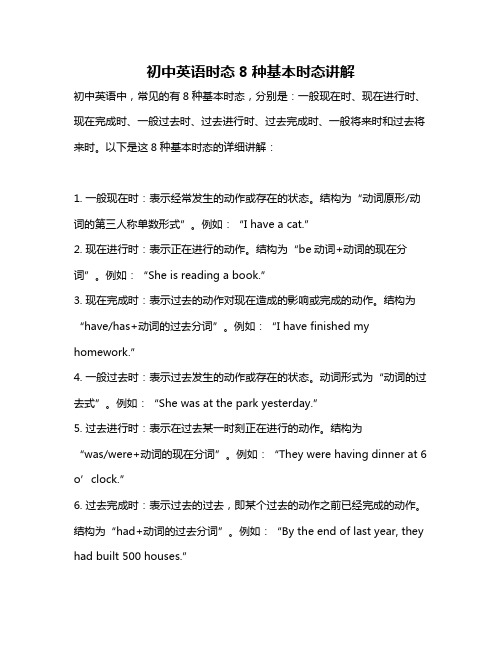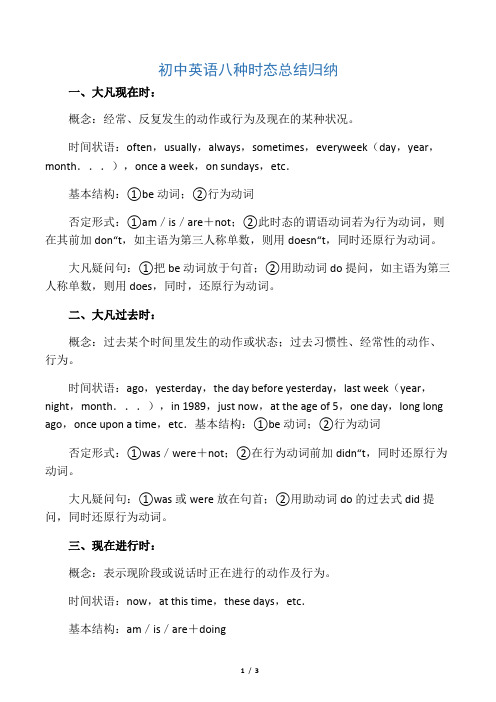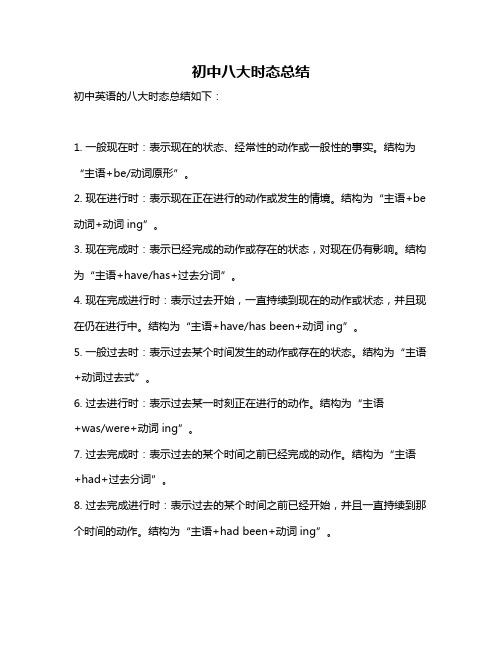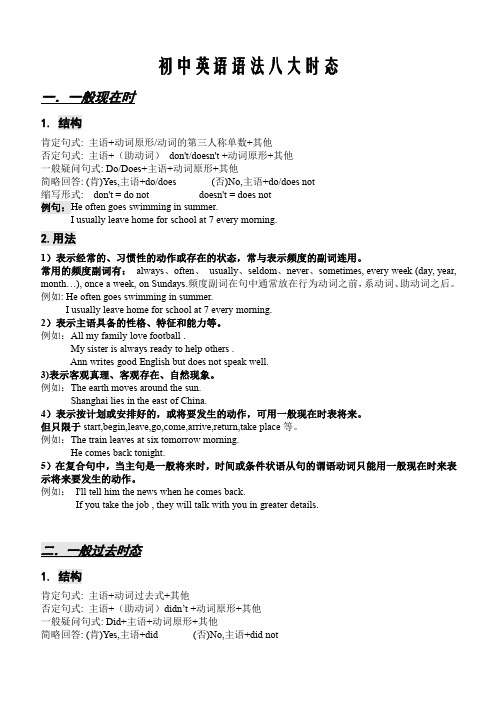初中英语八种时态(超详细)
初中英语时态8种基本时态讲解

初中英语时态8种基本时态讲解初中英语中,常见的有8种基本时态,分别是:一般现在时、现在进行时、现在完成时、一般过去时、过去进行时、过去完成时、一般将来时和过去将来时。
以下是这8种基本时态的详细讲解:1. 一般现在时:表示经常发生的动作或存在的状态。
结构为“动词原形/动词的第三人称单数形式”。
例如:“I have a cat.”2. 现在进行时:表示正在进行的动作。
结构为“be动词+动词的现在分词”。
例如:“She is reading a book.”3. 现在完成时:表示过去的动作对现在造成的影响或完成的动作。
结构为“have/has+动词的过去分词”。
例如:“I have finished my homework.”4. 一般过去时:表示过去发生的动作或存在的状态。
动词形式为“动词的过去式”。
例如:“She was at the park yesterday.”5. 过去进行时:表示在过去某一时刻正在进行的动作。
结构为“was/were+动词的现在分词”。
例如:“They were having dinner at 6 o’clock.”6. 过去完成时:表示过去的过去,即某个过去的动作之前已经完成的动作。
结构为“had+动词的过去分词”。
例如:“By the end of last year, they had built 500 houses.”7. 一般将来时:表示将来要发生的动作或存在的状态。
结构为“will+动词原形”或“am/is/are going to+动词原形”。
例如:“We will visit the museum next week.”8. 过去将来时:表示从过去的某一时刻看,将来要发生的动作或存在的状态。
结构为“would+动词原形”或“was/were going to+动词原形”。
例如:“He said he would come back soon.”以上就是初中英语8种基本时态的讲解,希望对你有帮助!。
(完整版)初中英语八种时态总结归纳

初中英语八种时态总结归纳一、大凡现在时:概念:经常、反复发生的动作或行为及现在的某种状况。
时间状语:often,usually,always,sometimes,everyweek(day,year,month...),once a week,on sundays,etc.基本结构:①be动词;②行为动词否定形式:①am/is/are+not;②此时态的谓语动词若为行为动词,则在其前加don“t,如主语为第三人称单数,则用doesn“t,同时还原行为动词。
大凡疑问句:①把be动词放于句首;②用助动词do提问,如主语为第三人称单数,则用does,同时,还原行为动词。
二、大凡过去时:概念:过去某个时间里发生的动作或状态;过去习惯性、经常性的动作、行为。
时间状语:ago,yesterday,the day before yesterday,last week(year,night,month...),in 1989,just now,at the age of 5,one day,long long ago,once upon a time,etc.基本结构:①be动词;②行为动词否定形式:①was/were+not;②在行为动词前加didn“t,同时还原行为动词。
大凡疑问句:①was或were放在句首;②用助动词do的过去式did提问,同时还原行为动词。
三、现在进行时:概念:表示现阶段或说话时正在进行的动作及行为。
时间状语:now,at this time,these days,etc.基本结构:am/is/are+doing否定形式:am/is/are+not+doing大凡疑问句:把be动词放在句首四、过去进行时:概念:表示过去某段时间或某一时刻正在发生或进行的行为或动作。
时间状语:at this time yesterday,at that time或以when引导的谓语动词是大凡过去时的时间状语等。
初中八大时态总结

初中八大时态总结
初中英语的八大时态总结如下:
1. 一般现在时:表示现在的状态、经常性的动作或一般性的事实。
结构为“主语+be/动词原形”。
2. 现在进行时:表示现在正在进行的动作或发生的情境。
结构为“主语+be 动词+动词ing”。
3. 现在完成时:表示已经完成的动作或存在的状态,对现在仍有影响。
结构为“主语+have/has+过去分词”。
4. 现在完成进行时:表示过去开始,一直持续到现在的动作或状态,并且现在仍在进行中。
结构为“主语+have/has been+动词ing”。
5. 一般过去时:表示过去某个时间发生的动作或存在的状态。
结构为“主语+动词过去式”。
6. 过去进行时:表示过去某一时刻正在进行的动作。
结构为“主语
+was/were+动词ing”。
7. 过去完成时:表示过去的某个时间之前已经完成的动作。
结构为“主语+had+过去分词”。
8. 过去完成进行时:表示过去的某个时间之前已经开始,并且一直持续到那个时间的动作。
结构为“主语+had been+动词ing”。
以上是初中英语八大时态的总结,希望对你有所帮助。
(完整版)英语常用的八种时态

英语时态初中阶段应掌握的时态共有八种,即一般现在时,一般将来时,一般过去时,现在进行时,过去进行时,过去将来时,现在完成时,过去完成时。
现从结构,作用,时间状语三方面加以介绍。
一、一般现在时其结构为:be动词肯定句主语+am,is,are+其它。
否定句主语+am,is,are + not+其它。
一般疑问句 Am,Is,Are+主语+其它?特殊疑问句特殊疑问词+am,is,are+主语+其它?实意动词1)主语为第一,二人称及第三人称复数时肯定句主语+动词原形+其它。
否定句主语+don't+动词原形+其它。
一般疑问句 Do +主语+动词原形+其它?特殊疑问句特殊疑问词+do+主语+动词原形+其它?2)主语为第三人称单数时肯定句主语+动词第三人称单数 +其它。
否定句主语+doesn't+动词原形+其它。
一般疑问句 Does+主语+动词原形+其它?特殊疑问句特殊疑问词+does+主语+动词原形+其它?其作用为:表示习惯性,经常性的动作;表示现在的状态与特征;表示普遍真理其常用时间状语为often,always,usually,sometimes,everyday(week,year...), in the morning (afternoon,evening)等。
Ex . 1. _______ she _______ (go)to the library every Sunday?此题为习惯性动作,答案为Does,go.2.They often _______(swim)in summer.此题为经常性动作,答案为swim.3.______(be)everyone here?此题表示现在的状态,答案为Is.4.The earth______(travel) round the sun.此题表示普遍真理,答案为travels.二、一般过去时其结构为:be动词肯定句主语+was,were+其它。
8个初中英语时态

8个初中英语时态8个初中英语时态是学习英语语法的重要组成部分,以下是它们的定义和例句:1. 现在一般时态:表示现在的动作或状态。
例如:I eat an apple every day. (我每天吃一个苹果。
)2. 过去一般时态:表示过去的动作或状态。
例如:She studied English last year. (她去年学了英语。
)3. 现在进行时态:表示正在进行的动作或状态。
例如:He is watching TV now. (他正在看电视。
)4. 过去进行时态:表示过去某个时间正在进行的动作或状态。
例如:They were having dinner when I called. (我打电话的时候他们正在吃饭。
)5. 现在完成时态:表示已经完成的动作或状态,强调对现在的影响。
例如:I have learned English for three years. (我已经学了三年英语了。
)6. 过去完成时态:表示过去某个时间之前已经完成的动作或状态。
例如:They had finished their homework by the time I arrived. (我到的时候他们已经完成作业了。
)7. 现在完成进行时态:表示从过去开始一直持续到现在的动作或状态,强调对现在的影响。
例如:He has been studying English for five years. (他已经学了五年英语了。
)8. 过去完成进行时态:表示从过去某个时间开始一直持续到过去的动作或状态。
例如:They had been waiting for the bus for an hour when I arrived. (我到的时候他们已经等了一个小时的车了。
)。
初中英语语法八大时态总结(完整版)

初中英语语法八大时态一.一般现在时1. 结构肯定句式: 主语+动词原形/动词的第三人称单数+其他 否定句式: 主语+(助动词) don't/doesn't +动词原形+其他 一般疑问句式: Do/Does+主语+动词原形+其他 简略回答: (肯)Yes,主语+do/does (否)No,主语+do/does not 缩写形式: don't = do not doesn't = does not 例句:He often goes swimming in summer. I usually leave home for school at 7 every morning.2.用法1)表示经常的、习惯性的动作或存在的状态,常与表示频度的副词连用。
常用的频度副词有: always、often、 usually、seldom、never、sometimes, every week (day, year, month…), once a week, on Sundays.频度副词在句中通常放在行为动词之前, 系动词、 助动词之后。
例如: He often goes swimming in summer. I usually leave home for school at 7 every morning. 2)表示主语具备的性格、特征和能力等。
例如:All my family love football . My sister is always ready to help others . Ann writes good English but does not speak well. 3)表示客观真理、客观存在、自然现象。
例如:The earth moves around the sun. Shanghai lies in the east of China. 4)表示按计划或安排好的,或将要发生的动作,可用一般现在时表将来。
(完整)英语8种时态
初中英语八种时态归纳复习时态是英语学习中一个至关重要的内容,广大初中学生在实际运用时,往往对时态问题倍感棘手,下面我们就归纳复习一下这几种时态。
一、一般现在时(一)定义表示经常性或习惯性的动作,或存在的状态,还表示主语具备的性格和能力及客观真理. 例:I get up at 6:30 in the morning 。
She is at home 。
(二)构成主要用动词原形表示,当主语是第三人称单数时,在动词词尾加s/es。
(三)句型1、肯定句:主语+谓语+其他. She reads English everyday 。
2、否定句:主语+don’t/doesn’t+谓语+其他。
He doesn’t get up at 6:30 in the morning .3、一般疑问句:Do/Does+主语+V原+其他?Do you like English ? Yes ,I do ./No,I don't 。
4、特殊疑问句:特殊疑问词+do/does+主语+V原+其他?What time do you get up every morning ? Where doesyour father work ?(三)用法1、表示经常性或习惯性的动作,或存在的状态,带与表示频率的时间状语如:often ,sometimes , usually,always , everyday year,month...), once/twice a week (month , year ,etc。
), seldom , on Sundays等连用。
I leave home for school at seven every morning 。
2、表示客观真理,科学事实、格言警句.The sun rises in the east .日出东方。
The earth goes around the sun .地球绕着太阳转。
Ten minus two is eight。
(完整版)初中英语八种时态总结归纳
初中英语八种时态总结归纳一、一般现在时:概念:经常、反复发生的动作或行为及现在的某种状况。
时间状语:often,usually,always,sometimes,every week(day,year,month...),once a week,on sundays,etc.基本结构:①be动词;②行为动词否定形式:①am /is /are +not;②此时态的谓语动词若为行为动词,则在其前加don't,如主语为第三人称单数,则用doesn't,同时还原行为动词。
一般疑问句:①把be动词放于句首;②用助动词do提问,如主语为第三人称单数,则用does,同时,还原行为动词。
二、一般过去时:概念:过去某个时间里发生的动作或状态;过去习惯性、经常性的动作、行为。
时间状语:ago,yesterday,the day before yesterday,last week(year,night,month...),in 1989,just now,at the age of 5,one day,long long ago,once upon a time,etc.基本结构:①be动词;②行为动词否定形式:① was/were +not;②在行为动词前加didn't,同时还原行为动词。
一般疑问句:①was或were放在句首;②用助动词do的过去式did提问,同时还原行为动词。
三、现在进行时:概念:表示现阶段或说话时正在进行的动作及行为。
时间状语:now,at this time,these days,etc.基本结构:am/is/are +doing否定形式:am/is/are +not+doing一般疑问句:把be动词放在句首四、过去进行时:概念:表示过去某段时间或某一时刻正在发生或进行的行为或动作。
时间状语:at this time yesterday,at that time或以when引导的谓语动词是一般过去时的时间状语等。
初中英语时态8种基本时态归纳
初中英语时态8种基本时态归纳初中英语八种基本时态包括:一般现在时、现在进行时、现在完成时、一般过去时、过去进行时、过去完成时、一般将来时、过去将来时。
以下是这八种基本时态的归纳:一般现在时:表示通常性、规律性、习惯性的状态或者动作(有时间规律发生的事件)的一种时间状态。
例句:I usually walk to school every day.(我每天通常步行上学。
)现在进行时:表示正在进行的动作或存在的状态。
例句:He is studying in his room now.(他现在正在房间里学习。
)现在完成时:表示动作发生在过去但与现在有关,强调对现在造成的影响或结果。
例句:I have finished my homework.(我已经完成了我的作业。
)一般过去时:表示在过去某个时间发生的动作或存在的状态。
例句:We went to the park yesterday.(我们昨天去了公园。
)过去进行时:表示在过去某个时间正在进行的动作或存在的状态。
例句:They were playing football at 3 o'clock yesterday afternoon.(昨天下午三点钟,他们正在踢足球。
)过去完成时:表示在过去某个时间之前已经完成的动作或存在的状态。
例句:He had finished his homework before dinner.(他在晚餐前已经完成了作业。
)一般将来时:表示将来的动作或状态,通常与“will”或“shall”连用。
例句:It will rain tomorrow.(明天会下雨。
)过去将来时:表示在过去某个时间之后将要发生的动作或存在的状态,通常与“would”连用。
例句:He said he would come to see me the next day.(他说他第二天会来看我。
)。
初中英语八大时态总结
初中英语八大时态总结英语中有很多时态,而初中阶段主要学习的有八大时态,它们分别是一般现在时、一般过去时、一般将来时、现在进行时、过去进行时、将来进行时、现在完成时和过去完成时。
下面就让我们来逐一总结这八大时态的用法和特点。
1. 一般现在时。
一般现在时表示经常性或习惯性的动作,或者客观真理。
例如,I play basketball every day.(我每天打篮球。
)Water boils at 100 degrees Celsius.(水在100摄氏度时沸腾。
)。
2. 一般过去时。
一般过去时表示过去某个时间发生的动作或状态。
例如,I visited Beijing last summer.(我去年夏天参观了北京。
)She studied hard for the exam.(她为考试努力学习。
)。
3. 一般将来时。
一般将来时表示将来某个时间会发生的动作或状态。
例如,I will go to the park tomorrow.(我明天会去公园。
)They are going to watch a movie this weekend.(他们周末会去看电影。
)。
4. 现在进行时。
现在进行时表示现在正在进行的动作。
例如,She is reading a book now.(她现在正在看书。
)They are playing football in the playground.(他们正在操场上踢足球。
)。
5. 过去进行时。
过去进行时表示过去某个时间正在进行的动作。
例如,I was studying when she called me.(她给我打电话的时候,我正在学习。
)They were playing games at that time.(他们那时在玩游戏。
)。
6. 将来进行时。
将来进行时表示将来某个时间正在进行的动作。
例如,I will be having dinner at 7 o'clock tonight.(我今晚7点会在吃晚饭。
- 1、下载文档前请自行甄别文档内容的完整性,平台不提供额外的编辑、内容补充、找答案等附加服务。
- 2、"仅部分预览"的文档,不可在线预览部分如存在完整性等问题,可反馈申请退款(可完整预览的文档不适用该条件!)。
- 3、如文档侵犯您的权益,请联系客服反馈,我们会尽快为您处理(人工客服工作时间:9:00-18:30)。
动词的时态在英语中,不同时间里以不同方式发生的动作或存在的状态,要用不同的动词形式来表示,动词的这种不同形式称为动词的时态。
时态从时间上划分,可分为四大类:现在时、过去时、将来时和过去将来时;从行为上,每一类可以分为四种形式:一般式、进行式、完成式和完成进行式。
这样英语的动词合起来,总共有十六种时态,初中只需掌握其中的八种时态。
以动词work为例:一、一般现在时1、概念:表示经常的、习惯性的动作或存在的状态。
2、构成:(1)当动词是be动词时,第一人称单数用am,第二人称或复数名词、代词用are,第三人称单数、单数名词或不可数名词用is。
(2)当动词是实义动词时,一般用动词原形。
但如果主语是第三人称单数时,动词必须用第三人称单数形式,其变化规则如下:助动词do(第三人称单数用does)构成否定句、疑问句及答语,但要注意助动词后原来的谓语动词要恢复原形。
如:I like music. 我喜欢音乐。
I don’t like music. 我不喜欢音乐。
Do you like music?你喜欢音乐吗?Yes, I do. / No, I don’t. 是的,我喜欢/不,我不喜欢。
3、用法(1)表示经常的、习惯性的动作或存在的状态。
常和often, usually, every day, sometimes, always , once a week (month , year , etc.) , seldom, ever, never, now and then, from time to time,nowadays等时间状语连用。
如:He goes to school by bus every day. 他每天坐公交去学校。
They often play football. 他们经常踢足球。
(2)表示主语的状态、性质、特征、性格、职业、能力等。
这里的目的是为了"描述现阶段的动作或状态",其重点"不是强调动作发生的时间、或进行的状态"。
如:Miss Gao teaches English. 高小姐教英语。
Do you speak Japanese? 你讲日语吗?He can speak five foreign languages. 他能说五种外语。
My sister is always ready to help others . 我妹妹总是乐于助人。
(3)陈述客观事实、普遍真理。
顾名思义,客观的情况是"没有时间概念"的;也"不会在意动作进行的状态"。
如:The sun rises in the east. 日出东方。
The earth goes around the sun. 地球绕着太阳转。
Ten minus two is eight. 十减二等于八。
Light travels faster than sound. 光的速度比声音的速度快。
The United States lies by the west coast of the Pacific Ocean.美国位于太平洋西岸。
Time and tide wait for no man. 时不我待。
(4)在时间状语和条件状语从句中,或在谈到计划、规定、安排或时刻表时,主句用一般将来时,从句用一般现在时表示将要发生的动作。
如:If I see him, I’ll tell him to give you a call.如果我见到他,我将告诉他给你回个电话。
We’ll wait until he comes back.我们将等着直到他回来。
The plane takes off at7:30. 飞机在7:30起飞。
Classes begin at 8:00. 8:00开始上课。
【注意】a.现在进行时有时用来代替一般现在时,表示一个经常性的重复的动作或状态。
这时句中常带always, forever以表示说话人的某种感情,如赞叹、厌烦等。
如:He is always thinking of others. 他总是为别人考虑。
The boy is always asking for money.这个男孩总是要钱。
b.一般现在时表示过去(1)用于某些动词(tell, say, hear, learn, gather等)表示不确定的过去时间。
如:I hear that he got married last month. 我听说他上个月结婚了。
Mary says you told her to come over here. 玛丽说是你让她到这儿来的。
(2)当要陈述一个客观事实时,有时即使有过去时间状语也可用一般现在时。
如:The story is set in the summer of1937. 故事的背景是1937年夏天。
The story begins in the year1937. 故事开始于1937年。
二、一般过去时1、概念:表示过去某个时间发生的动作或存在的状态。
2、构成:与人称、数的形式无关。
(1)当动词为be动词时,应该用相应的过去式:am /is——was are—— were否定形式为:was not——wasn’t were not——weren’t疑问句是将was, were置于主语之前。
如:I was in Grade Three last term. 我上学期在三年级。
I wasn’t in Grade Two last term. 我上学期不在二年级。
Which grade were you in? 你在哪个年级?(2)当动词为实义动词时,用动词的过去式,过去式的变化有规则和不规则变化。
①规则变化如下:②动词过去式的不规则变化需要逐个记忆。
见附录。
go——went begin——began sleep——slept run——ranI heard the good news just now. 我刚刚听到了这个好消息。
The twins didn’t go to school last week. 这对双胞胎上周没有去上学。
Did you see the film yesterday ? 你昨天去看这部电影了吗?3、用法(1)表示过去某一时间或一段时间发生的动作或存在的状态。
也可表示在过去某段时间里经常发生的习惯性动作。
常和表示过去的状语连用:yesterday,yesterday morning( afternoon, evening),the day before yesterday, last night (week ,month , year , century , etc.) ,a minute ago (two hours ago,four days ago,one week ago, tree years ago, …), then, at that time(moment),in1998, just now, in those days以及由after, before, when, while,whenever引导的的表示过去的时间状语等。
如:They had a baby last month. 他们上个月有了一个宝宝。
My mother was ill yesterday. 我的妈妈昨天生病了。
He went out just now. 他刚刚出去了。
When I was young, I played games with my brothers every day.在我小时候,我每天和我的哥哥们玩游戏。
(2)用于since引导的从句,主句的谓语动词如果用现在完成时,since引导的从句一般要用一般过去时。
如:He has worked in the factory since it opened in1990.他自从这家工厂在1990年营业就在那儿工作。
You haven’t changed much since we last met.自从我们上次见面你没改变多少。
(3)一般过去时表示现在①在宾语从句中,由于时态呼应的关系,可用一般过去时表示现在:I didn’t know you were here. 我不知道你在这儿。
(were实际上指现在)I didn’t know you were so busy.我没想到你这么忙。
(were实际上指现在)②表示客气委婉的现在:I wondered if you were free this evening. 不知您今晚是否有空。
I thought you might like some flowers. 我想您也许想要些花。
【注】能这样用的动词主要限于want, wonder, think, hope, intend等少数动词。
③用于某些特殊结构中表示现在:It’s time we started. 我们该动身了。
I wish I knew his name. 要是我知道他的名字就好了。
I’d rather you lived closer to us. 我希望你能住得离我们近点。
【注】该用法主要用于it’s time, I wish, I’d rather, if only, as if, as though 等少数结构后接从句的情形,其中有些结构后面的句子还可用一般过去时表示将来:I’d rather you came next Monday. 我宁愿你下周星期一来。
另外表主观想法的虚拟条件句也用一般过去时表示现在:If I had the money now I’d buy a car. 假若我现在有钱,我就买辆小汽车。
三、一般将来时1、概念:表示将来某个时间要发生的动作或存在的状态。
常与表示将来的时间状语连用:tomorrow,tomorrow morning/afternoon/evening, next week/month/year, in a few days, from now on,the day after tomorrow,soon等。
如:I’m going to visit the museum this Sunday.我这周日打算去参观这所博物馆。
I’ll be there in half an hour. 我将半小时后到那儿。
We’ll arrive tomorrow. 我们将明天到达。
2、构成及用法(1)will(第二、三人称) /shall(第一人称)+动词原形。
表示动作在现在或目前还未发生,要在将来的某个时间内发生,没有主观性,是“纯粹的将来动作”。
美语则不管什么人称,一律用will。
